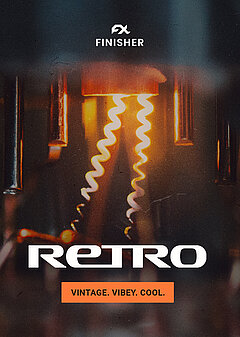How to Make Synthwave Atmospheres
Add the sound of the 80s to your EDM tracks, creating retro sci fi masterpieces on command and crafting the perfect leads & basses
DECEMBER 5TH, 2021
Read carefully until the end of this article to get an idea of how you can create amazing synthwave atmospheres:
Getting the “modern 80s” sound
When you hear synthwave, you immediately hear some critical differences in the mix versus most modern genres — one of the biggest elements at play is low pass filtering. Normally, you’ll hear this effect on tons of synths like basses, plucks, and tons of other patches ... but with synthwave, you’ll hear it subtly across the entire mix. As an example, compare synthwave with contemporary pop music and you’ll immediately hear the difference in the intensity of the top end. If you want to approximate it, take a low pass filter and use a gentle rolloff above 15kHz or so.
Gentle saturation is typically used in conjunction with filtering, emulating the sound of magnetic tape (on which nearly all music used to be released at one time). You’ll have to play with this a bit, as it’s easy to be heavy-handed (i.e. you don’t want audible distortion, just a little color). The type of saturation is important too — nothing too “digital” or harsh, as the goal is gentle warmth. You can get this sound by chaining multiple effects together, but you’ll have a much easier time using a multi-effect designed to achieve this specific sound. UJAM’s Finisher RETRO is the perfect fit, and you can simply scroll through a few presets until you find the one that best fits your unique mix — try out What Is Mono for some authentic 80s vibes. Tweak it to taste and you’re good to go!
If you want to get extremely literal, there are also a couple of other imperfections unique to magnetic tape that will get you even closer to the sound you want. One is physical degradation, creating short gaps in the audio and creating an irregular fluttering that can quickly become unpleasant — be careful not to overuse this as it will become unnatural very quickly. Another sound is far more noticeable: pitch wobble. Inconsistencies in the speed of the tape as it’s fed into the machine cause the pitch to go up and down slightly as the tape moves faster and slower, back and forth. Your DAW may have a way to recreate both of these effects, though if you want a plugin that can do both, RC-20 Retro Color lets you tear things up exactly how you like; you can also get more info in our companion article, The Ultimate Guide to Synthwave.
Basses
Depending on the 80s style being emulated (sci fi, ballad, dance, etc.), your bass sound will likely change drastically. For example, take a song like Ocean Drive — the bass is tight, punchy and is a nice blend of modern and classic qualities. The core sound is a supersaw (multiple sawtooth waves stacked together and slightly detuned for a thicker sound) with rapid, plucking filter movement. This is common across many 80s science fiction movies, and it’s great for driving the beat forward and filling in the space between the kick and snare.
Another type of bass frequently heard in older sci fi movies is brassier and more ambient in nature, starting in the foreground and rapidly moving into the background to set the mood or sidechained to the beat. Streetwalker is a great example of this, and the gradual fade-out reveals itself even more so in the supersaw chords around 1:11 into the song. The sound is thick, blurred, and there’s no clear delineation between it and the rest of the audio tracks, contributing to a smooth texture across the entire mix.
If you want to go all out, there are also examples of hybrid growls, somewhere between a plucked bass and a complex, modern FM-based growl like you hear in dubstep. Check out Star Fighter and you’ll hear an excellent example of this blend, which is again perfect for sci fi scenes, amongst other things — you’ll find many examples of this as you dive deeper into the world of synthwave, especially looking at much of the album art you’ll discover. Neon lights, flying cars and old-school futuristic robotics all contribute to the atmosphere of synthwave, even beyond what you hear in the music itself.
Leads
One of the most common synth leads is designed to sound vaguely like a full violin section and is created by a combination of supersaws (are you noticing a theme here?) mixed with heavy reverb. You can hear this in the song Propagation around 0:52 as a glistening lead line emerges, hanging suspended over the rest of the mix as each note ever so gradually fades away into a wash. It’s easy to hear the saturation, filtering and pitch wobble we discussed above, which give it a loose, meandering sort of quality.
Some synthwave leads are more liberal in their use of pitch fluctuations and introduce vibrato at the oscillator level within the synthesizer patch. Vibrato is slow, up to about 6Hz, and is typically constrained to a very narrow depth (you can still clearly hear the pitch). Musicians commonly use a level of vibrato to add interest to sustained notes; bowed string instruments are perhaps the best example of this. The thinking in adding this to synths was to make them sound more like real instruments, and now it’s one of the most effective ways to make it abundantly clear you’re hearkening back to the 80s with your music!
You can manipulate pitch in other ways too, such as the lead does in the very beginning of That House — it’s a type of supersaw, which as usual consists of multiple sawtooth waves layered and slightly detuned to make the quality richer and fuller. Half a minute in, a different lead takes up the mantle and you can hear an excellent example of hard pitch and filter envelopes. You can hear variations of this classic pluck sound across many different genres, and the differences largely come down to the shape of those envelopes and how much you compress the tail and bring out the back-end material. Again, you can hear the gradual pitch wobble responsible for much of the 80s sound you hear.
The role of reverb
In the case of synthwave, this merits its own section — reverb is a huge part of the genre’s sound, and failing to fully appreciate this will lead to either a painfully dry mix or a boomy mess. Take drums, for example: we cover them in more detail in our article, How To Make Synthwave Drum Patterns With Beatmaker VICE, but suffice it to say that synthwave drums use gated reverb that blooms quick and then rapidly drops in volume, creating a big sound that doesn’t ring out for very long. This keeps the percussion tight and powerful, making room to pull out the stops with other instruments. If you want to remove the guesswork from creating this sound, give Beatmaker VICE’s I’m Mad a try and lay down the percussion you want!
With leads, chord instruments and other audio tracks, you’ll need to use your judgment, but there’s a trend you can follow which often leads to pleasing results: outside of drums, synthwave reverbs have a very long, linear decay that deliberately sound artificial — it doesn’t follow the organic contour of reverb in real spaces, and it’s not designed to. The idea is to create a space that’s impossible to believe, allowing everything to coalesce into one grand background palette.
If you have difficulty keeping this background full and stable, you can use an upward compressor to catch the quiet stuff and push it back up to the level you want. Most compressors are downward compressors, meaning that they push all audio above the threshold down according to the ratio you set; upward compressors do the opposite, marking any signal below the threshold to be increased in volume according to the ratio chosen. If you have a low signal and want to bring it back up and recapture some of the lost material, this is how to do it!
Something to take note of when you’re listening to synth tails: not all of the fading signal is reverb. Rather, it’s largely a long release setting on the volume envelope causing the sound to gradually diminish after each note has been played, which was often done to simulate reverb with no outboard effects — combine gradual releases with thick reverb, and you’ll instantly have a thicker, more authentic synthwave mix!
Wrapping up
Synthwave is about much more than mimicking the sound of 80s magnetic tape and getting a big drum sound; there’s a ton of careful attention to detail involved, especially with choosing the best filtering, saturation, pitch wobble settings and more. Balancing the sound of authentic 80s records and modern production techniques is tricky, as you’ll be tempted to make tons of decisions that don’t fit contextually (for example, adding more high-end “air” when you should roll off the top end instead). The best producers in the genre have this balancing act nailed down, and it may be the most difficult aspect of the entire synthwave production process.
How accurate you want to get is up to you, though it’s worth noting that when listening to producers like Dance With the Dead and Virtual Mage, everything in the mix is accounted for. The reverb is smooth, the leads and chords feel just right and the bass has just the right amount of grit without sounding out of place. Some do it all by building up from the simplest level, but others use tools specifically designed to get the job done at hand, like RETRO and VICE —and when you’re still “learning to walk,” your best bet is often to take as much guesswork out of it as possible. That’s what we’ve done with all of our plugins to date without sacrificing clarity and depth; if you want to take advantage of these tools, you can be up and running faster than ever. Happy producing!
About the Author
Harry Lodes is a copywriter, marketing consultant and content writer for audio and ecommerce brands. He lives in the Philadelphia area, releasing Eastern/Western hybrid EDM under the artist name KAIRI hearkening back to his roots in Berklee College of Music.
Stay up to date
Sign up and we’ll send you an e-mail with product news and helpful stuff every now and then. You may unsubscribe at any time.
Defy Limits
We develop software solutions that enable people to create, consume and interact with music.




